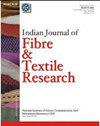使用蓝桉叶染料提取物对棉花进行可持续驱蚊整理
IF 0.6
4区 工程技术
Q4 MATERIALS SCIENCE, TEXTILES
引用次数: 0
摘要
人们已经尝试开发出一种纺织品,这种纺织品可以通过将纳米颗粒以指纹的形式传递给蚊子,从而有效地阻止蚊子进入房间。研究中使用的活性物质是桉树叶纳米颗粒,有两种形式,即煅烧前和煅烧后,每种都有两种浓度。采用改进的世界卫生组织(WHOPES)兴奋室试验方法,比较纳米颗粒打印的样品与未打印纳米颗粒的对照样品对按蚊的驱蚊效果。开发的样品还进行了耐久性测试,直到15次洗涤循环。结果表明,桉树叶提取物与纳米颗粒两种形式的复合打印样品的驱蚊效果均显著提高。该研究还表明,10%的纳米颗粒煅烧前后的效果达到90%。这一发现表明,含有10%煅烧前后颗粒的样品即使在10次洗涤后也具有很高的驱蚊效果,具有商业可行性。这些织物可用于窗帘和门帘,以减少蚊子的进入。本文章由计算机程序翻译,如有差异,请以英文原文为准。
Sustainable mosquito repellent finish on cotton using Eucalyptus globulus leaf dye extracts
An attempt has been made to develop textiles, which can actively repel the mosquitoes from entering into the rooms byimparting nanoparticles in the form of prints. The active material used in the study is eucalyptus leaf nanoparticles in twoforms, viz pre and post calcinated, each in two concentrations. The samples printed with nanoparticles are compared withthe control sample (printed without nanoparticles) for mosquito repellent efficacy against Anopheles mosquitoes, using themodified WHOPES Excito chamber test method. The developed samples are also tested for durability to laundry until 15wash cycles. The results show that the printed samples using eucalyptus leaf extracts in combination with nanoparticles intwo forms have significantly higher mosquito-repellent efficacy. The study also reveals that 90% efficacy is achieved with10% pre and post calcinated nanoparticles. The finding implies that samples printed with 10% pre and post calcinatenanoparticles have high mosquito-repellent efficacy even after 10 wash cycles and have commercial viability. These fabricscan be used for curtains and screens for doorways to reduce the entry of mosquitoes.
求助全文
通过发布文献求助,成功后即可免费获取论文全文。
去求助
来源期刊

Indian Journal of Fibre & Textile Research
MATERIALS SCIENCE, TEXTILES-
CiteScore
1.20
自引率
0.00%
发文量
43
审稿时长
6-12 weeks
期刊介绍:
Started in 1976, this journal publishes papers on both fundamental and applied research in various branches of textile technology and allied areas such as Production and properties of natural and synthetic fibres (including industrial fibres), yarns and fabrics; Physics and chemistry of fibre forming polymers; Chemical and finishing processes; Fibre-reinforced composites; Garment technology; Analysis, testing and quality control; Application of microprocessors; Instrumentation; application of nanotechnology in textiles; and Industrial engineering.
 求助内容:
求助内容: 应助结果提醒方式:
应助结果提醒方式:


